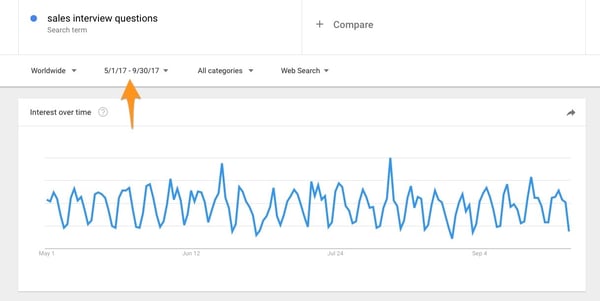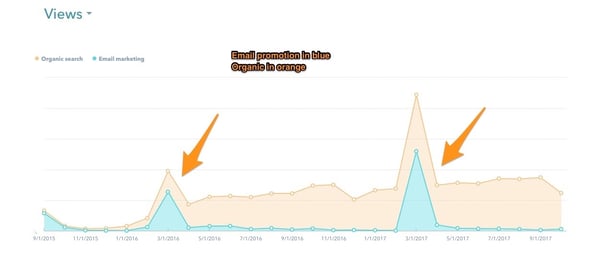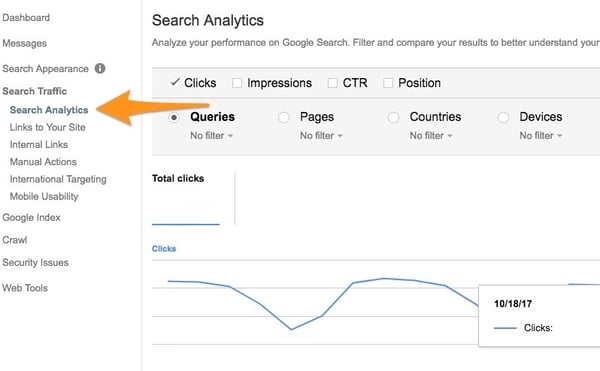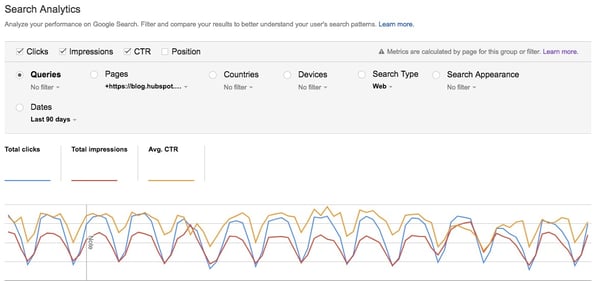Wan na see something scary?.jpg?t=1511521815126&width=600&name=ack%20( 1 ).jpg)
That, my friends, is exactly what I would call a definite down pattern– and for a post that, at its peak, got 10,000 views per month.Maybe it looks familiar. And possibly it doesn’t, but it looks like something you want to prevent at all costs.Either way– if you’re an online marketer that plays any function in managing your brand’s blog site– read on.We’re going to review a few of the methods to prevent that huge, frightening traffic trend above– or to prevent it from occurring once again, if you’ve seen it before.First, we’ll begin
with the concerns you need to ask if you have actually discovered your SEO rankings drop. Then, once we’ve covered all those bases, we’ll enter into ways to proactively remain on top of your rankings, to obtain into good habits that can assist you preserve your blog site’s SEO health.Ready to get into identifying those bothersome blog site posts? Let’s get begun.1. Is the search term itself losing traction?Go to SEMrush and enter the post URL into the leading search bar. Google Analytics(GA )does not pull the”https://”part of a URL, so ensure you manually enter it. Find the highest-volume keyword the post is ranking in the top 5 for. It should be fairly basic;
for instance, in September 2017,”40 Sales Interview Questions to Employee the Finest Reps in 2017″ranked # 2 for “sales interview questions. “Go to Google Trends and get in that keyword . The default time range is one year.
You might require to change the date to see more micro trends; I chose 5/1/2017 to 9/30/17 to see the Might through September modifications.

If interest in the term is stable– or up and to the right– it’s the post, not your audience.2. Has the post declined in the rankings for a major keyword?Go back to SEMrush and go into the post in the top search bar once again. Change the date variety under”Live information”
in the leading right to your highest-traffic month. (It needs to upgrade to state “Historical information.”)Export this list as a CSV. Do not leave the SEMrush page with the rankings for the post
you’re analyzing– you’ll be returning to it in a bit.Open the spreadsheet, and relabel the tab”[ High-Traffic Month] [Year]
.jpg?t=1511521815126&width=600&name=rank-changes%20( 1 ).jpg)
(for instance,”May 2017″. ) Bring Up the SEMrush window again. Change the date range to the most recent month.Export this list as a CSV.Delete columns D-K. Copy and paste the contents of
-1.jpg?t=1511521815126&width=600&name=sept%20( 1 )-1.jpg)
this spreadsheet into a tab on the first spreadsheet. Relabel the tab “[ The Majority Of Recent Month] [Year](
“September 2017”).
Go to the first tab. Add a Column D titled”
[ A Lot Of Recent Month]
[ Year] Rankings”.(For instance,”September 2017.”
)Place this formula into cell D2.= VLOOKUP(A2, September 2017
.jpg?t=1511521815126&width=600&name=negative-rank-changes%20( 1 ).jpg)
! A: B, 2, FALSE)Click the small box in the lower right-hand corner to apply the formula to the staying rows.Add a Column E and call it “Up or down?”Place this formula into E2: Highlight Column E. Click”Apply Conditional Format”→ “Highlight Cell Rules” →” Less Than “and place”0.
“Now every unfavorable rank modification is highlighted in red. Notice any especially high-volume keywords you dropped in rank for.
In this case, we went from # 1 to # 2 for”sales interview questions”(
2900 month-to-month search volume) and from # 1 to # 3 for “inside sales interview questions” (720 monthly search volume

).3. How recently have you upgraded the post?If you have not touched it in over six months, a fresher and more thorough link might be winning.Action item: Update the post with extra material, more current links, etc. 4. How just recently have you promoted the post in an email?A big bump in traffic
from our email customers generally raises rankings: Action item: Consist of the post in an e-mail send out, either as the very first or 2nd link
.(Any lower, and it won’t get clicks, rendering this method pointless.)5. Are the posts that have surpassed it in the online search engine results pages higher-quality; e.g., more extensive, more examples, much better graphics/visuals? That most likely suggests their time-on-page is
greater and bounce rate is lower. They might be getting more recommendation traffic than you as well.Action item: Do whatever your competitors are doing … but better. If their guides include a subject-matter specialist, feature two subject-matter professionals. (Since this is a time- and energy-intensive technique, don’t utilize it unless you have actually exhausted all the others, or this is a truly competitive and important keyword.)
6. Are you getting less backlinks than your competitors/has your number of backlinks declined?As sites vanish or alter, you naturally lose backlinks.You can discover this info on SEMrush by entering the post URL in the leading search bar and scrolling down up until you see this: Action product: Estimate one or more influencers– either by pulling from something they have actually released, or reaching out for a direct quote– then, inquire to share the post with their audiences.7. What if your ranking hasn’t dropped?See if the
keyword now has a search feature.Featured snippet(
- FS)Individuals also ask (PAA
- )Carousel Here’s an example of how a carousel result would search for a topic related to sales: … and for the FS and PAA boxes: These usually appear in exactly what’s called the”position zero “slot, meaning whatever below is bumped down. Unexpectedly, the # 1 ranking remains in 2nd place.Action product: Aim to improve upon the existing FS.
Can you supply the very same info however with less jargon? With more detail? Greater precision? This obviously changes on a case-by-case basis, but normally, the bit isn’t perfect.See if there’s an advertisement– or several.Paid results can likewise– often simultaneously– be at
fault.Take an appearance at the results for”The best ways to utilize CRM”: Sadly, there isn’t really much that can be done about these paid outcomes– other than to simply accept the dip in traffic.Use Google Search Console.Google Search Console can also assist detect the issue.In the left sidebar, pick Browse Traffic → Search Analytics:< img src="https://blog.hubspot.com/hs-fs/hubfs/sc-1.jpg?t=1511521815126&width=600&name=sc-1.jpg"width= "600"caption ="false"data-constrained ="true"alt="sc-1 "title ="sc-1" > Next, click “Pages”→

” Filter Pages”→”URLs Containing”, then paste the URL of the post you’re evaluating.
“URLs Containing” is more effective to “URL is exactly” because you do not wish to miss out on any customized variations of that URL, i.e. one with UTM parameters.Then, click”Dates”→ “Set date variety”→”Last 90 days”– that’s as far back as Google will go.

Here’s exactly what those leading
- checkboxes indicate: Clicks: The raw number of clicks from the SERPs Impressions: The number of times the page appeared on the SERP CTR
- : Clicks divided by impressions Position: Typical ranking for all the different queries this page shows up for. (Take this metric with a grain of salt– if you’re # 1 for a low-volume question and # 9 for a high-volume one, your Position will be 5, even though one rank is far more important than the other.)
It may be helpful to look at the modifications in Clicks, Impressions, and CTR individually, as examining all them provides you this:

< img src ="https://blog.hubspot.com/hs-fs/hubfs/ahhhh.jpg?t=1511521815126&width=600&name=ahhhh.jpg"width="600 "caption="incorrect" data-constrained="true "alt =" ahhhh.jpg"title="ahhhh.jpg">

A little frustrating, no?First, let’s look at clicks. (I’m still examining”40 Interview Questions. “) Looks like clicks are decreasing somewhat.(

The valleys are the weekends, when far less individuals

are browsing for professional/educational material. )< img src="https://blog.hubspot.com/hs-fs/hubfs/impressions.jpg?t=1511521815126&width=600&name=impressions.jpg"width= "600"caption ="incorrect"data-constrained="true"
alt=”impressions”title
=” impressions “> Impressions are fairly steady. Aha! Here’s the problem. In late September, clickthrough rate (CTR)began falling.Analysis 101: If impressions are
consistent, however your clicks (and for that reason CTR)are dropping, your rank is dropping and/or a search function is pressing your result further down the page.If impressions are decreasing, but clicks and CTR are continuous, seasonality/declining search interest is most likely to blame. Verify with Google Trends.If impressions are increasing and CTR is dropping, meaning clicks aren’t growing proportionally greater, examine if you’re ranking for an image. You ought to likewise check whether your post has started ranking for more long tail keywords– ranking for more keywords, while an excellent thing(topics/over keywords), will constantly lead to higher impressions, but clicks may suffer as you may not always rank extremely for those longer tail keywords.Now scroll down and look at the most typical inquiries leading people to your page. Does the content on the page reflect exactly what they’re looking for?I’ve highlighted the inquiries this post will not answer. Choose whether it’s worth updating the post to resolve these content spaces. Because this one is about talking to salesmen, not marketers, I’m not going to include marketing interview concerns– that ‘d be too from left field. And since “sales interview workouts” sounds like a completely separate post, I’m not going to add that in, either.However, in some cases you discover an appropriate angle that’s missing from your post. When that’s the case, by all methods, go ahead and include it– it can just help.How to Remain on Top of Your Rankings If you’re a blog site editor, author, or supervisor, I advise running a report
at the end of on a monthly basis to see which of your home’s leading URLs have lost traffic.Periodically evaluating these: Assists you rescue pages prior to they permanently insinuate the rankings Exposes search trends Offers you a sense of your audience’s interests– both steady and altering The first time you do this analysis, pick your highest-traffic month from the previous half-year.
Using a medium -or low-traffic month will provide you a more conservative
price quote of which URLs have declined in organic traffic, which may camouflage pages in trouble.In GA, go to the left-hand sidebar and click” Habits” →” Website Material” →”All Pages.” Include your segment and pick your date
variety. If you’re evaluating a residential or commercial property that doesn’t have
a given sector, click”Advanced” and apply this filter:” Include “”
Page””Containing””[ Property URL] “Scroll to the bottom and modification”Program rows to 500.” Open your spreadsheet, name the very first tab”[. Month] [Year], then rename Column B” Views [Month] [Year], and erase all other columns.Go back to GA. Modification the date variety to the
most recent totally completed month (i.e. if you’re doing this on October 30, the date range would be September 1, 2017 -September 30, 2017.)Your filter and the variety of rows from the previous month you pulled
ought to still apply, so all you have to do is click” Export to CSV.” Open your spreadsheet, rename Column B” Views [Month
] [Year], and delete all other columns. Copy the contents of this spreadsheet, then paste it into the second tab of your highest-traffic month spreadsheet. Name the second tab “[ Month] [Year]. Return to your very first tab. Call Column C “Views [Month] [Year] “In cell C7, insert this formula:=VLOOKUP(A7,’Sept 2017′! A
: B, 2, FALSE )Click the box in the right-hand corner of the cell to apply this formula to the remaining rows.Rename Column D to
“15+%decline? “Insert this formula into D7:=IF (C7< (B7-(B7 * 0.15 )),
“YES”,<"")
Apply the formula to the remaining rows.Click “Conditional Formatting”,”Highlight Cell Guidelines,””Text that Consists of …”and set “Particular text” “including””Yes” to red.

Therefore, If You Keep In Mind Absolutely Nothing Else …
1. Each month, run a report to identify the top posts that have decreased in traffic.2.
Identify whether the search term is decreasing in traffic (absolutely nothing you can do) or whether the post itself is dropping in rank (lots you can do).3.
If it’s the latter, detect the particular issue(s) using SEMrush and Google Browse Console.Yes, this process
is a time- and energy-intensive one. It’s easier to repair your car than buy a brand-new one– and hope you haven’t gotten a lemon).
Carrying out upkeep on your blog site’s greatest hits takes fewer resources than composing a net-new one … and is normally even more effective.

.jpg?t=1511521815126&width=600&name=ack%20( 1 ).jpg)

.jpg?t=1511521815126&width=600&name=rank-changes%20( 1 ).jpg)
-1.jpg?t=1511521815126&width=600&name=sept%20( 1 )-1.jpg)
.jpg?t=1511521815126&width=600&name=negative-rank-changes%20( 1 ).jpg)











